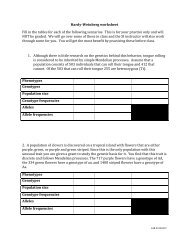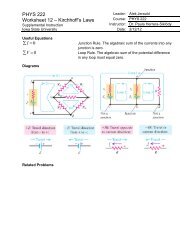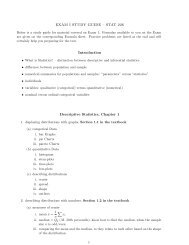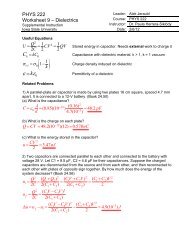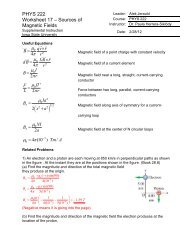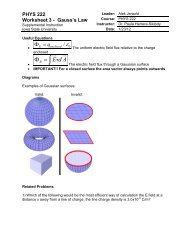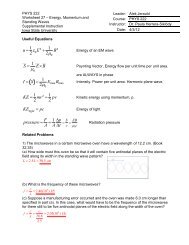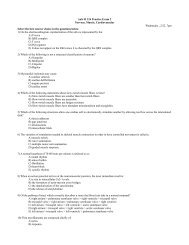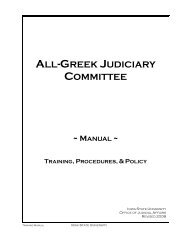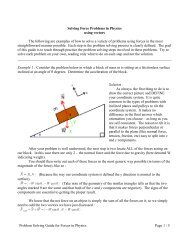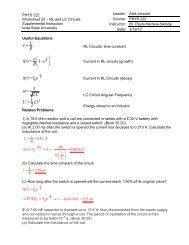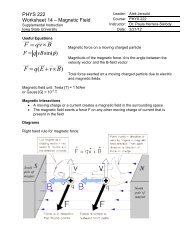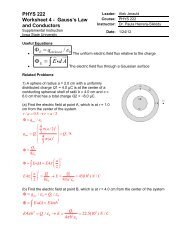Protists
Protists
Protists
Create successful ePaper yourself
Turn your PDF publications into a flip-book with our unique Google optimized e-Paper software.
The <strong>Protists</strong><br />
A diverse assemblage of eukaryotes<br />
that ARENʼT<br />
fungi, plants, or animals<br />
Why can termites eat wood?<br />
Because of<br />
symbiotic<br />
hypermastigotes<br />
(a group of<br />
parabasilids) living<br />
in the termite gut<br />
working together<br />
with Archaean<br />
methanogens<br />
Fig 28.26 (SEM)<br />
Where Did Eukaryotic Cells come from?<br />
First found in fossil record about 2.1<br />
billion years ago<br />
(Prokaryote fossils to 3.5 BYA)<br />
Two major features to explain:<br />
- membrane-bounded organelles<br />
(mitochondria and plastids)<br />
- internal membrane systems<br />
Page ‹#›<br />
In what ways are protists important?<br />
Base of many “food chains” - especially<br />
in aquatic settings<br />
Clarify water by filtering out small<br />
particles<br />
Some are parasites that cause<br />
diseases in other organisms<br />
Some have economic uses for humans<br />
Some are involved in important<br />
symbiotic relationships…<br />
And… they are a spectacular group<br />
of organisms<br />
Origin of Organelles<br />
Idea is that the ancestors of<br />
eukaryotic cells were symbiotic<br />
consortiums of prokaryotic cells<br />
Has come to be called the<br />
“endosymbiont theory”
Lynn Margulis<br />
Person who led the development of the endosymbiont theory<br />
Origin of<br />
Eukaryotes<br />
Fig.25.9<br />
Evidence (cont.)<br />
Similar membrane proteins (inner<br />
membrane)<br />
Reproduce by a process similar to<br />
binary fission<br />
Contain circular DNA molecules<br />
Ribosomal RNA sequences in<br />
organelles more similar to<br />
prokaryotes<br />
Page ‹#›<br />
The Ideas of the Endosymbiont<br />
Theory (Fig 25.9)<br />
Mitochondria are the descendents of<br />
aerobic heterotrophic bacteria<br />
Chloroplasts are the descendants of<br />
photosynthetic bacteria - very likely<br />
cyanobacteria<br />
Evidence that Supports the<br />
Endosymbiont Theory<br />
Endosymbiotic relationships exist in<br />
the modern world, e.g., some<br />
species of dinoflagellates are<br />
endosymbiotic in corals<br />
Plastids and mitochondria about the<br />
same size as typical prokaryotic<br />
cells<br />
What organisms have eukaryotic cells?<br />
Animals (mitochondria)<br />
Plants (mitochondria and plastids)<br />
Fungi (mitochondria)<br />
<strong>Protists</strong> (mitochondria, some have<br />
plastids)
The <strong>Protists</strong><br />
Incredible diversity of organisms -<br />
your text recognizes 21 clades at<br />
probably the Phylum or Kingdom<br />
level<br />
Typically found in aquatic or damp<br />
environments, or in body fluids,<br />
tissues, or cells of host organisms<br />
Most have flagella or cilia at some<br />
stage in their life cycle<br />
Cilia and Flagella in Action<br />
Cilia and Flagella<br />
Kelp (Brown Algae)<br />
Definitely donʼt need a microscope to see this protist!<br />
Page ‹#›<br />
Structurally<br />
distinct from<br />
the flagella of<br />
prokaryotes<br />
Eukaryotic<br />
flagella and<br />
cilia have a<br />
similar<br />
structure<br />
involving<br />
microtubules<br />
Flagella and Cilia (Fig 6.23)<br />
Protist Size<br />
Human sperm<br />
Ciliate<br />
Most are single-celled, but their cell<br />
structure can be very complex<br />
Ciliates (e.g., Paramecium,<br />
Vorticella) are among the most<br />
complex of all cells<br />
Some are multicellular and<br />
individuals can be as large as 60<br />
meters in length - the “kelps”<br />
(brown algae)<br />
Protist Nutrition<br />
Nutritionally diverse<br />
- photoautotrophs<br />
- chemoheterotrophs<br />
Also are<br />
“mixotrophs”<br />
e.g., Euglena
Nutrition<br />
Three major means of obtaining<br />
nutrition amongst protists:<br />
- Ingestive (“animal-like”), sometimes<br />
called “protozoa”<br />
- Absorptive (“fungus-like”)<br />
- Photosynthetic (“plant-like”),<br />
sometimes called “algae”<br />
Distinct nutritional mechanisms may be<br />
found within one Clade<br />
Fig 28.3<br />
Why not look at ALL 21 clades?<br />
Getting a Ph.D. - Thatʼs where you learn<br />
more and more about less and less until<br />
you know everything about nothing<br />
Intro Bio Course - Thatʼs where you learn<br />
less and less about more and more until<br />
you know nothing about everything<br />
I want you to know something about<br />
something...<br />
Page ‹#›<br />
Protistan Phylogeny<br />
“Kingdom Protista” was a diverse group of<br />
organisms that were, in many cases, not<br />
closely related<br />
Phylogeny is currently in a “state of flux”<br />
DNA sequence data have been, and will<br />
continue to be, very helpful<br />
Splitting of “Kingdom Protista” into 21<br />
clades (Phyla? Kingdoms?) has been<br />
proposed<br />
These clades have been placed into 5<br />
“supergroups” in your text<br />
Protistan Diversity<br />
A quick look at 9 of the 21 protist<br />
clades described in Campbell et al.<br />
Supergroup Excavata<br />
Evidence:<br />
- Excavated feeding groove<br />
- DNA sequence similarities<br />
Evidence supporting this “supergroup” is<br />
rather weak and investigation is ongoing
The Parabasalids<br />
Have modified mitochondria called<br />
“hydrogenosomes”<br />
Most familiar member Trichomonas<br />
vaginalis - cause of a common<br />
sexually transmitted disease<br />
Trichomonas Fact Sheet at the CDC<br />
Each cell possesses 4 flagella<br />
The Euglenozoans<br />
Two major groups:<br />
the kinetoplastids<br />
the euglenids<br />
Tsetse Fly<br />
Page ‹#›<br />
Trichomonas vaginalis<br />
(Fig. 28.4)<br />
The Kinetoplastids<br />
One large mitochondrian per cell<br />
Organized mass of DNA inside the<br />
mitochondrian - called the “kinetoplast”<br />
Genus Trypanosoma<br />
cause of “African sleeping sickness”<br />
Disease is vectored by the “Tsetse fly”<br />
(Glossina spp.)<br />
Invariably fatal if left untreated<br />
Fig.<br />
28.6<br />
Red blood cell Trypanosome
Supergroup Chromalveolata<br />
Evidence:<br />
- DNA sequence similarities<br />
- Chloroplast structure similarities<br />
Highly controversial “supergroup”<br />
The Dinoflagellates<br />
Both marine and freshwater<br />
Most species unicellular<br />
Important component of “plankton”<br />
About 50% of known species are<br />
photosynthetic<br />
Most species have elaborate cell<br />
walls<br />
Boat<br />
“Red Tide”<br />
Dead Fish<br />
Page ‹#›<br />
The Alveolates<br />
Characterized by the presence of<br />
small membrane-bounded cavities<br />
under their cell membrane<br />
Three major groups:<br />
Dinoflagellates<br />
Apiocomplexans<br />
Ciliates<br />
Ceratium (light<br />
microscope)<br />
Dinoflagellates<br />
Red Tide<br />
Peridinium<br />
(SEM)<br />
Dinoflagellate population explosions<br />
Water stained brownish-red<br />
(xanthophylls)<br />
Toxins produced by the<br />
dinoflagellates can kill fish,<br />
invertebrates, seabirds<br />
Some types of toxins can<br />
accumulate in shellfish - causing<br />
poisoning in humans
Karenia brevis<br />
One species of dinoflagellate that<br />
causes red tides<br />
Produces a toxin that kills fish and<br />
invertebrates<br />
Human exposure to the toxin may<br />
cause a variety of symptoms,<br />
including death - Called “neurotoxic<br />
shellfish poisoning”<br />
Location of Karenia blooms<br />
(data from December 2004)<br />
The Cilates<br />
Many beautiful freshwater species<br />
Use cilia to move and feed<br />
Have very complex cells, e.g., each<br />
cell has one micronucleus and one<br />
macronucleus<br />
Micronuclei participate in sexual<br />
reproduction; macronuclei in<br />
controlling cell functions<br />
Page ‹#›<br />
Karenia brevis (SEM)<br />
Unit 1 Exam<br />
Available Monday 15 September<br />
through Tuesday 23 September<br />
READ: “COLL Testing Facility Policies<br />
and Procedures” in the Course<br />
Introduction Learning Module<br />
Go to Center for On-Line Learning,<br />
room 60 Carver Hall to take the exam<br />
Ciliates<br />
Stentor spp. Paramecium spp.
Paramecium feeding<br />
Stramenopile Flagella (Fig 28.12)<br />
The Diatoms<br />
glass-like cell walls - made of<br />
hydrated silica<br />
important photosynthetic organisms<br />
in “plankton”<br />
fresh water and marine<br />
large number of species (estimated<br />
to be ~ 100,000)<br />
Page ‹#›<br />
The Stramenopiles<br />
Some species are photoautotrophic,<br />
some are heterotrophic<br />
Characterized by the presence hairlike<br />
projections on one of their<br />
(typically) two flagella<br />
Four major groups:<br />
Diatoms<br />
Brown algae (includes “kelp”)<br />
Golden algae<br />
Oomycetes (water molds)<br />
Diatom Diversity<br />
(Fig 28.3)<br />
Diatoms<br />
Diatom Art
Diatomaceous Earth<br />
Huge amounts of ancient diatom cell walls<br />
Various uses:<br />
filtering medium<br />
metal polishes<br />
reflective paint<br />
pesticide<br />
nanotechnology<br />
The Red Algae<br />
SEM of Diatom<br />
No flagella present at any stage of the<br />
life cycle<br />
Most abundant in tropical oceans<br />
Most are multicellular<br />
~ 6,000 described species<br />
Some species are heterotrophic<br />
Red Algae<br />
Accessory<br />
pigments allow<br />
photosynthesis<br />
at great depths -<br />
as deep as 260<br />
meters<br />
Effective at<br />
absorbing blue<br />
light<br />
Page ‹#›<br />
Supergroup Archaeplastida<br />
Evidence:<br />
- DNA sequence similarity<br />
- Chloroplast structure similarities<br />
This “supergroup” is well supported<br />
by the available evidence<br />
Red Algae (Fig 28.19)<br />
Human Uses<br />
Cell wall extracts:<br />
carageenan - commonly<br />
eaten by people…<br />
agar - microbiological<br />
culturing media
Fig. 28.19<br />
How do you feel about sushi?<br />
Chloroplasts<br />
Nucleus<br />
Single-celled Green Alga -<br />
Eremosphaera viridis<br />
Colonial Green Alga - Volvox (Fig. 28.3)<br />
Page ‹#›<br />
The Green Algae<br />
Most species (~7,000) found in fresh<br />
water<br />
Cell walls with a relatively high<br />
percent of cellulose<br />
Can be unicellular,<br />
colonial/filamentous, or multicellular<br />
Can be motile (flagella) or non-motile<br />
Chlamydomonas<br />
Unicellular and motile green alga<br />
Important model genetic system - much<br />
research is done with this organism<br />
Volvox
Filamentous Green Alga -<br />
Ulothrix spp.<br />
Green Algal Life Cycles<br />
Can be quite complex with both sexual<br />
and asexual reproduction<br />
Most gametes have two flagella<br />
Gametes may be isogamous or<br />
anisogamous<br />
Some multicellular species exhibit<br />
alternation of generations (as do all<br />
plants)<br />
- may be heteromorphic or<br />
isomorphic<br />
Oedogonium Life Cycle<br />
Page ‹#›<br />
Multicellular<br />
Green Alga -<br />
Ulva spp.<br />
(Fig. 28.21)<br />
An example of a green algal<br />
life cycle<br />
Oedogonium is a genus of<br />
filamentous green algae<br />
Anisogamous<br />
Oedogonium life cycle<br />
Meiosis leads to production of<br />
“zoospores” (not gametes)<br />
Gametes are produced by mitosis<br />
Asexual “macrozoospores” are also<br />
produced by mitosis
Supergroup Unikonta<br />
Evidence:<br />
- DNA sequence similarities<br />
This “supergroup” is well supported by<br />
the available evidence<br />
Plasmodial Slime Molds<br />
Feeding stage is an called a<br />
“plasmodium” (Fig. 28.24)<br />
Page ‹#›<br />
The Amoebozoans<br />
Four major groups:<br />
Plasmodial slime molds<br />
Cellular slime molds<br />
Gymnamoebas (free-living)<br />
Entamoebas (parasitic)<br />
The plasmodium is a<br />
“coenocytic mass”<br />
Multinucleate<br />
cytoplasm undivided<br />
by walls or<br />
membranes<br />
Live in moist habitats,<br />
e.g., rotting logs<br />
The plasmodium<br />
engulfs food by<br />
“phagocytosis” as do<br />
ameobas<br />
Cool Slime Mold Slime mold in “action”<br />
Planet Earth - Jungles 23:20
Response to the Environment<br />
~ 48 hours<br />
Start End<br />
Growth away from detergent<br />
Gymnamoebas<br />
Unicellular<br />
Found in soil, freshwater, and marine<br />
habitats<br />
Heterotrophs that often consume<br />
prokaryotes and other protists as<br />
their food<br />
Move by producing pseudopodia<br />
Attack of the Killer Amoeba<br />
Page ‹#›<br />
Slime Mold Reproduction<br />
If available water or food insufficient,<br />
produces resistant spores through<br />
meiosis<br />
Each<br />
sporangium<br />
produces<br />
many spores<br />
(Fig. 28.24)<br />
Amoeba spp. (Fig. 28.3)<br />
Studying organisms too small to see<br />
without a microscope is…<br />
1. Boring beyond<br />
human tolerance<br />
2. Very boring<br />
3. More interesting<br />
than I expected - but<br />
still boring<br />
4. Remarkably<br />
interesting<br />
5. More interesting<br />
than any previous<br />
experience in my life
The most interesting (or least boring)<br />
group weʼve studied so far is<br />
1. Archaea<br />
2. Bacteria<br />
3. Excavata<br />
4. Chromalveolata<br />
5. Archaeplastida<br />
6. Unikonta<br />
Page ‹#›




